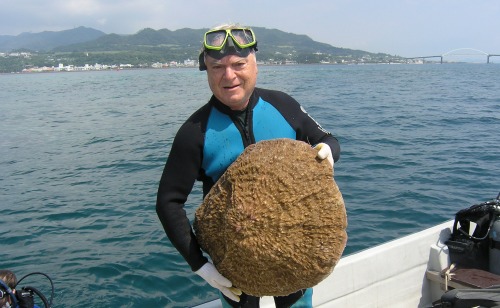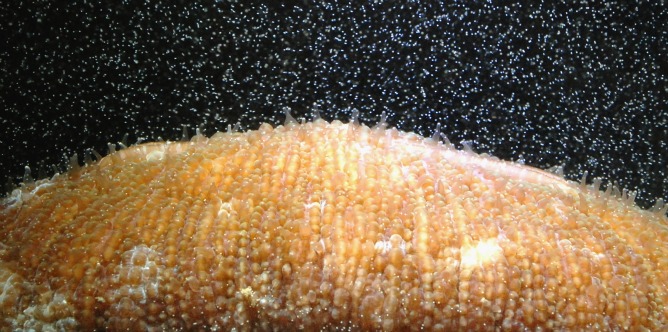Marine biologist Yossi Loya didn’t set out to scrutinize the sex lives of Japanese mushroom coral. But when he began to examine how this unusual species was coping with global warming, he witnessed its extraordinary gender-reversal approach to reproduction.
“Sex change in corals is the most exciting research I’ve ever done,” admits the Tel Aviv University professor, who is the only Israeli ever to win the
Darwin Medal of the International Society for Reef Studies and the first ecologist in 50 years to be elected to the Israel Academy of Sciences and Humanities.
Over the course of more than a decade, Loya and Okinawan researchers at the Sosoko Marine Science Lab discovered that unlike most coral, of which 85 percent are hermaphrodites, mushroom coral switch genders repeatedly during their reproductive years. Nobody had seen this phenomenon in previous coral studies, Loya tells ISRAEL21c.
Evolutionary ingenuity
As he has been documenting in scientific journals, one of these corals reverses its gender annually in middle age. The youngsters, all males, become female and retain their gender in their later years.
Based on his expertise with coral over the past 40 years, Loya assumes this phenomenon is an evolutionarily ingenious way for the coral to conserve energy while increasing their overall reproductive success.
“The recipe to succeed in evolution is to produce as many children as you can so they’ll arrive to a reproductive state and continue to spread your genes,” he explains. It seems likely that mushroom coral individuals of intermediate sizes lack the energy needed for female reproduction year after year. Changing their gender to male in alternate years allows them to conserve energy until they reach the critical size at which they can acquire enough energy to remain female.
While working toward his master’s degree at Tel Aviv University, he met the late Prof. Lawrence Slobodkin, a foremost American ecologist visiting Israel as a guest lecturer. By invitation of Slobodkin, the newlywed Loya left Israel right after the Six-Day War to follow his mentor. While earning his doctorate at the State University of New York-Stony Brook on New York’s Long Island, Loya innovated a method for measuring the health of a coral reef, which marine scientists still use to this day.
Mini reef, major publications
“There are no coral reefs at Stony Brook,” he admits. However, through Slobodkin, he returned to Israel on a Smithsonian Institution grant to quantify the community structure and species diversity of reef corals in Eilat, something that had never been done before.

“Eilat has one of the smallest coral reefs in the world,” he reveals. It measures just 1.9 miles kilometers, as compared to Australia’s 1,553-mile Great Barrier Reef, where Loya heads a study center staffed by 150 graduate students.
However, he jokes, “the number of publications on coral reef studies in Israel is the highest in the world – per square meter.” He is responsible for many of those, having written two books on coral reef ecology and more than 215 journal articles on ecology, evolution and life history strategies of stony corals.
A full professor at Tel Aviv University in marine ecology since 1985 and former dean of the Faculty of Life Sciences, Loya has been a visiting professor at institutions and universities in Australia, Massachusetts, California and Japan.
‘From underwater rainforest to underwater desert’
The scientist is increasingly concerned about the effect of global warming on coral reefs, often called the “rain forests of the sea” for their highly diverse ecosystem. “Once corals are affected, everything else dependent on the corals is affected as well,” he states. “They form the basic structure of the reef, which provides hiding places for many varieties of fish, invertebrates and other organisms.”
Following the particularly hot summer of 1998, one-fourth of the world’s coral reefs turned white and corals literally starved to death due to the loss of algae supplying most of their nutrients. In Japan, Loya and his colleagues found that 85% of the coral reefs around Okinawa were dead, and about 10 species had become extinct. “It had gone from an underwater rainforest to an underwater desert,” he says.
It was during this investigation that Loya happened upon the astonishing sex-changing behavior of a particular type of coral never studied before.
“Corals have many reproductive strategies, which explains their 250 million-year-old evolutionary success,” he says. Coral reproduction everywhere corresponds to moon cycles. The Japanese mushroom coral release their eggs and sperm into the water for exactly five nights after the full moon every July and August, starting at 10pm and finishing at 4am “You can set your watch to it. Their biological clock is unbelievable,” he concludes.














